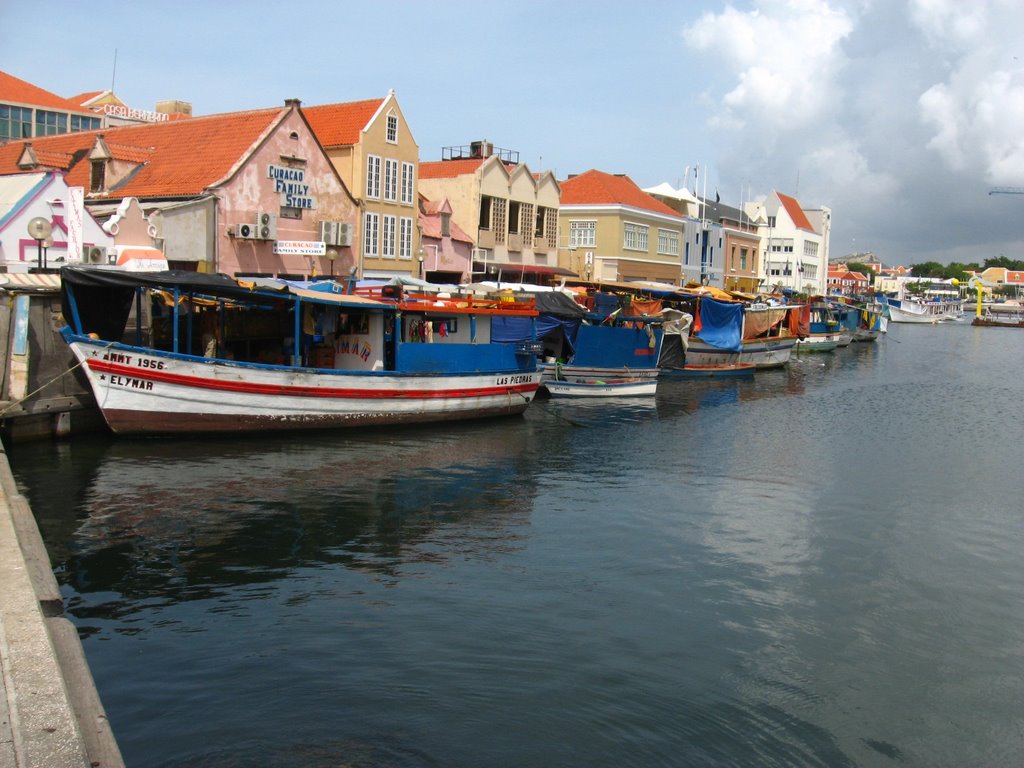How little did I know about Curaçao until a recent Twitter exchange with a fellow traveler and suddenly a few others piped in. A little research later, I discovered some of their fabulous outdoor markets. Imagine colorful wooden boats loaded with fruits and vegetables. They dock along the Sha and Lionel Caprileskade in Punda and set up stalls brimming with fresh fish, produce, honey, cigars, vegetables, fruits and other delicacies.
Barku (“fresh”, salt, and sweat) fills the air. The merchants are from Venezuela, not from Curaçao and the tradition has been passed down through generations of men who hail from poor Venezuelan coastal towns (40 miles from Curaçao) who leave their wives and kids behind in Tierra Firme for months on end – so that they can support them. Apparently, they live aboard their wooden boats and have created their own little Venezuelan community within Punda.
In Punda, you must take in the Floating Market as well as visit the plaza Jo Jo Correa, where there is often a small artisans’ market featuring local crafts.
Curaçao is located in the southwestern Caribbean, an island which is just 70 km (44 miles) north of South America. It is 2 1/2 hours by air from Miami. The island is 56 km (35 miles) off the coast of Venezuela, a 45-minute flight from Caracas.
New Market
The new market is housed in a distinctive round building beyond the Queen Wilhelmina footbridge, just down the street from the floating market. Locally grown fruits, vegetables, and some imported produce are sold from bustling stalls in Punda’s covered round central market. On weekday mornings, city office workers stop at the stands to grab sandwiches made of freshly baked rolls. Several stalls also sell handicrafts from islands around the Caribbean.
MarsheBieuw (the Old Market)
Do as the Curaçao people do for lunch, and sample authentic local food at Curaçao’s famous Old Market. You will find it when you pass the new market and take a right a the post office. Hygiene and food quality are excellent, portions are generous, and prices can’t be beat. Seating is strictly first come, first served, at a few small tables or long counters. Each stand is independently operated. Notice the small paintings depicting rural life of old that adorn the vents above the cooking areas.
And, after you have finished with the markets, be sure to check out one or more of their 17 exquisite beaches. Almost all Curacao beaches are scattered along the sheltered and calm southwestern coast, where the waters are calm and crystal clear. At some beaches admission is charged, sometimes including a beach chair. Even though it is not common, nor acceptable practice at all beaches, you may see European visitors sunbathing topless. Please note that this is not permitted by law, but is tolerated at a few of the beaches.
A few worth noting include Blue Bay Beach, a large shady beach just northwest of Willemstad, near the village of Sint Michiel, with lots of facilities, Boca Santa Cruz, which has a mangrove swamp surrounding this wide beach, dotted with palm trees, clouds the water, creating less than ideal conditions for snorkeling, Caracasbaai, a beach made of coarse sand and pebbles which is popular for snorkeling and diving because its part of the underwater park, Cas Abao, which offers you a white sandy beach, crystal clear waters, waving palm trees and many gazebos for shade, Jan Thiel Beach, which is located in a new upscale residential area east of town, Kenepa, which includes two beautiful coves which are among the island’s most popular beaches. Intimate Playa Kenepa is partly shaded by manchineel trees.
Photo credits: panoramio.com and Curacao Tourism Board.

Renee Blodgett is the founder of We Blog the World. The site combines the magic of an online culture and travel magazine with a global blog network and has contributors from every continent in the world. Having lived in 10 countries and explored over 90, she is an avid traveler, and a lover, observer and participant in cultural diversity. She is also the founder of the Magdalene Collection, a jewelry line dedicated to women’s unsung voices and stories, and the award-winning author of the bestselling book Magdalene’s Journey
She is founder of Blue Soul Media and co-founder of Blue Soul Earth as well as the producer and host of the award-winning Blue Soul CHATS podcast, that bridges science, technology and spirituality. Renee also founded Magic Sauce Media, a new media services consultancy focused on viral marketing, social media, branding, events and PR. For over 20 years, she has helped companies from 12 countries get traction in the market. Known for her global and organic approach to product and corporate launches, Renee practices what she pitches and as an active user of social media, she helps clients navigate digital waters from around the world. Renee has been blogging for over 16 years and regularly writes on her personal blog Down the Avenue, Huffington Post, BlogHer, We Blog the World and other sites. She was ranked #12 Social Media Influencer by Forbes Magazine and is listed as a new media influencer and game changer on various sites and books on the new media revolution. In 2013, she was listed as the 6th most influential woman in social media by Forbes Magazine on a Top 20 List.
Her passion for art, storytelling and photography led to the launch of Magic Sauce Photography, which is a visual extension of her writing, the result of which has led to producing six photo books: Galapagos Islands, London, South Africa, Rome, Urbanization and Ecuador.
Renee is also the co-founder of Traveling Geeks, an initiative that brings entrepreneurs, thought leaders, bloggers, creators, curators and influencers to other countries to share and learn from peers, governments, corporations, and the general public in order to educate, share, evaluate, and promote innovative technologies.










